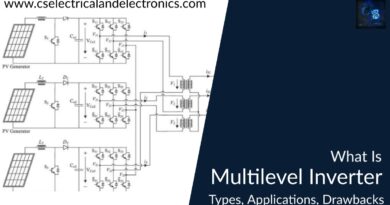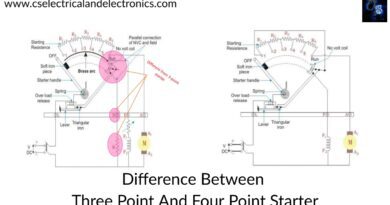Types Of Protection In Transmission Lines Used In The USA/United States
Hello guys, welcome back to my blog. In this article, I will discuss the types of protection in transmission lines used in the USA or the united states, the function of each protection system, the application of each system, etc.
If you have any doubts related to electrical, electronics, and computer science, then ask questions. You can also catch me on Instagram – CS Electrical & Electronics And Chetan Shidling.
Also, read:
- Top 10 Python Frameworks And Libraries For Electrical Engineers
- What Is C Rate In Battery, Why It Is Important, C Rate Calculation
- Top 20+ Electric Vehicle Projects With MATLAB Simulink File In 2022
Protection In Transmission Lines Used In The USA
The Transmission is the most important network in the power system as it will act as a bridge between the power generation and power consumption at the load centres. The transmission was firstly done in the direct current (DC) at low voltage in the early days as the technology updated in the electrical sector the transmission is shifted towards the Alternating Current (AC) at the high voltage at low cost and high efficiency.
This AC transmission led to a new era in the transmission from any distance and nowadays the HVDC (High Voltage Direct Current) transmission is the trending technology of transmission as it transmits the high voltage in DC irrespective of distance with fewer losses and high efficiency.
The transmission plays a crucial role as it will be responsible for supplying the voltage at the consumer load ends. The transmission lines will be travelling at different distances from the power station to the load centres, so they will face some network issues and faults which will lead to losses and the line components damage.
The length of the transmission line is very long and it will run in open atmospheric conditions so the probability of fault occurrence will be comparatively high compared to the electrical equipment in power systems such as alternators and power transformers. So in the power system compared to all the divisions the electrical transmission needs high protection.
The protective schemes will be different for the transmission lines compared to the other protective schemes in the power system. The transmission line possesses various relays and circuit breakers for protecting the line from faults. The transmission lines are long enough so the plenty number of the relays and circuit breakers are placed in the transmission during the process of line construction as there are some limitations for each of the relays and circuit breakers such as the relay at the fault line should only operate other than all other relays and the circuit breaker at the fault point must trip the circuit for rectifying the faults.
So for this type of protection, there are separate protective schemes only used for the transmission line protection which are completely different from the transformer and alternator protection at the generator stations. The components are very high in the transmission as the power must be transmitted through long distances so the protective schemes are majorly divided into three types such as:
- Distance Protection
- Over Current Protection
- Differential Protection
Types Of Protection In Transmission Lines
01. Distance Protection:
The distance protection mainly depends on the distance relay which is popularly known as the impedance relay. As we all know that the resistance is directly proportional to the length of the line as well as in the transmission lines the impedance is directly proportional to the length of the transmission lines. The distance protection’s main concept is to set the impedance value and when the fault occurs in the line the relay must check the impedance at the fault point and the set value of impedance, if the impedance is at a faulty point on the transmission line is less than the set value of impedance then the relay operates and the circuit breaker will break the circuit and clears the fault.
The faults at different distances can be measured in the specific km distance which is the speciality of the distance protective scheme. The distance protection is also called impedance protection which is divided into different zones to simplify the circuit and the operation of the protective scheme. According to the fault occurrence in the particular distance zone, the relay will operate and rectify the faults.
The three zones are mainly classified as Zone-1,2 and 3 their work is mentioned below:
Zone-1: Zone -1 is the primary distance protection that will protect the whole line without any time delay during the fault occurrence. By eliminating all errors and the other losses the protection is given as 80%.
Zone-2: Zone-2 is the backup distance protection and the primary protection for the adjoint lines the remaining 20% of zone-1 is fulfilled in this zone-2.
Zone-3: Zone-3 is the full backup protection for the adjoint lines and the transmission lines.
02. Differential Protection:
The differential protection basically works on the principle when the fault occurs the leaving current will differ from the current entering into the circuit. The current transformers are used on either side of the equipment which will monitor the current values entering the circuit and leaving the circuit when the difference occurred between the currents then the fault occurrence is detected and the relay in combination with the circuit breaker will act on the faults until it is eliminated.
The differential protection scheme uses the current transformers as the communication channel to connect and observe the value of the other side of the transmission lines. The fault occurrence will denote the changes in the leaving current hence the relay operates and rectifies the fault. The differential protection is also called the Merz-price protection and it is mainly used for transformer protection. This is the main working of differential protection.
03. Over Current Protection:
The overcurrent protection is used for the protection of the transmission lines from phase to phase faults and ground faults. The Overcurrent relays are connected all over the transmission at three phases as each one per phase. The phase-phase faults will cause the high current flow then over current relay will operate and the minimization of the fault will be done as well as the earth to phase faults will produce the small currents into the supply which will lead to the fault current then the overcurrent relay will operate and clears the faults. The time-based operation is also possible in the overcurrent protection. The Overload will also cause the high current generations then the overcurrent relays will rectify the faults.
The above mentioned three types of protection in transmission lines are used in the USA or United states.
Also, read:
- 10 Tips To Maintain Battery For Long Life, Battery Maintainance
- 10 Tips To Save Electricity Bills, Save Money By Saving Electricity
- 100 (AI) Artificial Intelligence Applications In The Automotive Industry
- 100 + Electrical Engineering Projects For Students, Engineers
- 1000+ Control System Quiz, Top MCQ On Control System
- 1000+ Electrical Machines Quiz, Top MCQs On Electrical Machines
- 1000+ MATLAB Simulink Projects For MTech, Engineering Students
- 50 Tips To Save Electricity At Home, Shop, Industry, Office
Author Profile
- Chetu
- Interest's ~ Engineering | Entrepreneurship | Politics | History | Travelling | Content Writing | Technology | Cooking
Latest entries
 All PostsApril 29, 2024Top 11 Free Courses On Battery For Engineers With Documents
All PostsApril 29, 2024Top 11 Free Courses On Battery For Engineers With Documents All PostsApril 19, 2024What Is Vector CANoe Tool, Why It Is Used In The Automotive Industry
All PostsApril 19, 2024What Is Vector CANoe Tool, Why It Is Used In The Automotive Industry All PostsApril 13, 2024What Is TCM, Transmission Control Module, Working, Purpose,
All PostsApril 13, 2024What Is TCM, Transmission Control Module, Working, Purpose, All PostsApril 12, 2024Top 100 HiL hardware in loop Interview Questions With Answers For Engineers
All PostsApril 12, 2024Top 100 HiL hardware in loop Interview Questions With Answers For Engineers








